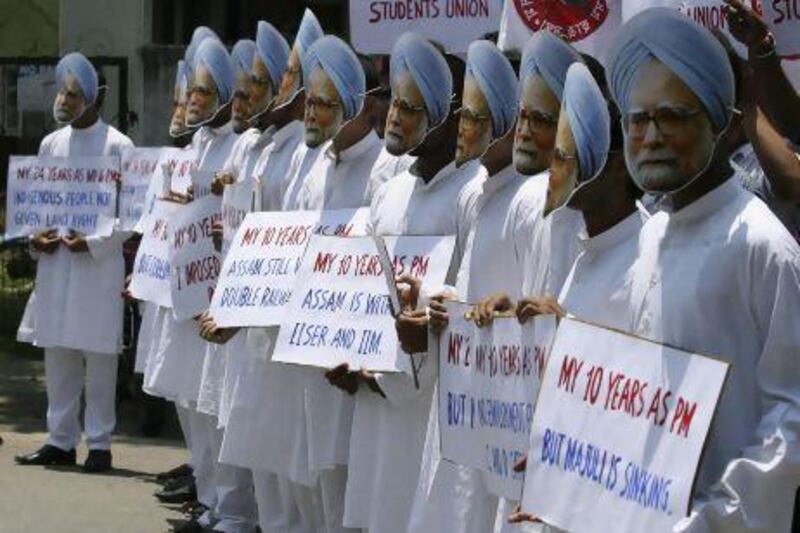NEW DELHI // In an early volley of campaigning for national elections next year, India's ruling coalition has launched a media blitz aimed at persuading the nation's 714 million voters that it deserves to stay in power.
Advertisements lauding the government's rural-employment programme appeared on the front pages of Indian newspapers yesterday. And in coming weeks, videos praising other accomplishments of the United Progressive Alliance (UPA) - the ruling coalition that is dominated by the Congress Party, during its nine years of rule will be broadcast on television - disseminated on social media and screened in cinemas.
The videos, directed by Pradip Sarkar and featuring a signature song written by Javed Akhtar, bear Bollywood's indelible stamp.
The song's lyrics - Meelon ham aa gaye, meelon hame jaana hai ("We've come a long way, but there's still a long way to go") - will soon be available as a ringtone.
But saturating the airwaves, newspapers and mobile phones with political self-adulation is no guarantee of success at the polls in India.
In 2009, the UPA spent about 1 billion rupees (Dh67 million) on its advertising campaign and won the general election.
Yet Prodyut Bora, a senior official in the Bharatiya Janata Party (BJP), said it would be "too simplistic to say that the UPA won due to better advertising".
Indeed, the BJP spent 1.5 billion rupees on its "India Shining" campaign in the 2004 elections and still lost power to the Congress-led UPA.
At a preview of the UPA's ad campaign on Monday, India's minister of information and broadcasting insisted the ruling coalition's drive was different to the BJP's.
"This is not 'India Shining' but the actual story of India that we are trying to present to you through these 12-13 spots," Manish Tewari said.
The UPA will spend 1.8 billion rupees promoting its achievements, including about 350 million rupees in the first 15-day phase of the campaign. Collectively titled "Glimpses of the India Story", the videos attempt to depict what the government says is its positive effect on the lives of Indians.
In one, a female day labourer has learnt enough in her evening classes to demand her rights. In another, women are seen using improved maternity facilities at hospitals.
Villages get concrete roads, and Indians of every class come together to take new metro lines to work. Graduates of the elite Indian Institutes of Technology find that they can find rewarding employment at home, instead of having to migrate to the United States to put their education to good use.
But the videos may be too little too late for a government that has been plagued by scandals involving corruption and abuses of power.
A week ago, one of its ministers resigned after he was implicated in a scandal in which Indian Railways posts were allegedly sold for bribes. Another stepped down over allegations he had interfered with an investigation of the government.
An executive for a Chennai-based advertising agency poured scorn on the coalition's campaign strategy.
"The UPA somehow seems to think that a clunkily conceived, shoddily produced, and hastily released ad campaign can erase the perception of non-performance," said Anantha Narayan, creative director of 1Pointsize. Political parties frequently made the mistake of "a last-minute tom-tom of the past", Mr Narayan said.
"If the UPA were my client, I'd have a simple mantra for them: 'Stop advertising, start talking'," he said.
The UPA operates from a disadvantaged position that makes even talking a challenge, Mr Narayan suggested. The coalition's three pillars - prime minister Manmohan Singh, the Congress chief Sonia Gandhi, and her son Rahul Gandhi - are "terrible communicators".
"One of them needs to step up to the plate and assume the role of brand ambassador," he advised.
A heavily media-oriented political campaign also assumes the availability of electricity and television - a dubious assumption in India, said Mr Bora, a member of the BJP national executive who ran the online campaign in 2009 for the party's prime ministerial candidate.
Using his home state of Assam as an example, Mr Bora said that many areas of the country had sporadic electricity and access to television - or none at all.
In these areas, grassroots efforts by the party's rank and file are far more important in communicating the party's message and in getting out the vote, he said.
Mr Bora also doubted that the UPA's advertising strategies could rehabilitate its image.
"Can good advertising sell a new product from a failing company?" he wondered. "It would take one hell of a brave advertising agency to come up with one hell of a campaign to sell a product with such a visible expiry date."
[ ssubramanian@thenational.ae ]
twitter: For breaking news from the Gulf, the Middle East and around the globe follow The National World. Follow us





